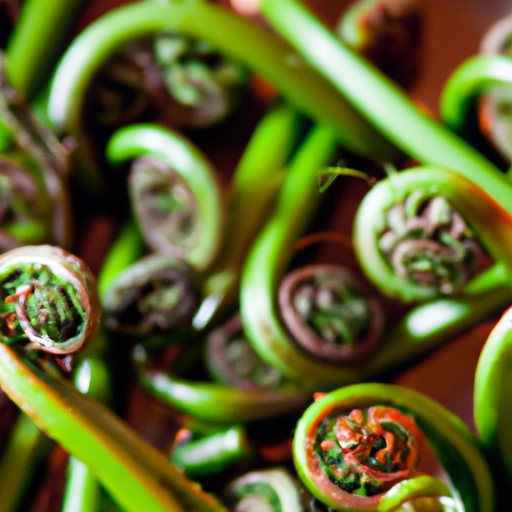Fiddlehead
Description

Fiddleheads are the tightly coiled, new growth shoots of ferns, harvested for their unique texture and flavor. Resembling the scroll of a violin, hence the name, these edible spirals are a sought-after ingredient during their brief spring season. Packed with nutrients, fiddleheads offer a fresh, grassy, and slightly nutty taste that complements a variety of dishes.
Common uses
Fiddleheads are often used as a vegetable side dish, in salads, and as a complement to proteins such as fish and chicken. They can be pickled for preservation or used as a garnish to add texture and a visual accent to plates.
Nutritional value
Calories
Approximately 35 calories per 100 grams (3.5 oz).
Protein
Contains around 4 grams of protein per 100 grams.
Fat
Fiddleheads are low in fat, with less than 0.4 grams per 100 grams.
Carbohydrates
There are about 5.5 grams of carbohydrates per 100 grams of fiddleheads.
Vitamins
Rich in vitamin A and a good source of vitamin C.
Minerals
Contains iron, magnesium, and potassium.
Health benefits
Fiddleheads are known for their antioxidant properties and may contribute to immune system health. Their fiber content can aid digestion, and the presence of vitamins and minerals supports overall well-being.
Potential risks
Raw or undercooked fiddleheads can carry foodborne illness risks and should be thoroughly cooked before consumption. Some individuals may also have allergic reactions to this fern species.
Common recipes
Fiddleheads are often featured in stir-fries, omelets, pasta dishes, and as a pizza topping.
Cooking methods
Blanching, sautéing, steaming, or pickling are recommended methods for preparing fiddleheads.
Pairing with other ingredients
They pair well with garlic, lemon, butter, and light vinaigrettes, enhancing their natural flavor.
Summary
Fiddleheads are a nutritious and flavorful springtime vegetable enjoyed around the world. With proper preparation, they offer a delightful addition to a range of dishes, contributing both taste and health benefits to your meals.